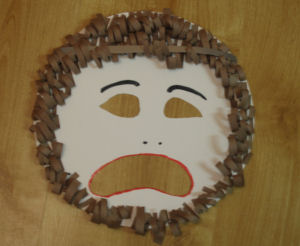To be honest, it isn’t really possible to keep calm and carry on during the last week of school. There is so much anticipation for the summer holidays that everyone is feeling a little giddy with excitement. However, it is possible to keep your students occupied and happy, and not push yourself too far towards further exhaustion by involving your students in an all-ages/all abilities project that takes little preparation and that can evolve over an afternoon or a few days.
Although workbooks and school materials may have begun to make their way home, usually you can find the bare minimum of materials the students will need to complete this project. What they need, they often make themselves or find in the school yard if you don’t have it in the classroom. The project involves students making a board game that employs elements of math, arts, and language. As an added challenge, perhaps they can include an aspect from a strand in science or social studies topic that will truly be a culmination of their learning over the year. Sometimes, however, the games are modeled on games they already know well, such as Pokemon or Mindcraft. Regardless of the genesis of ideas, students seem to have plenty of enthusiasm for creating a game and for fine-tuning it so that is will be successful.
Materials needed;
• Scrap paper for rough copies
• 1 sheet of legal-sized paper, car stock or poster board per person/group for final copy
• Pencils, erasers, markers
• Rulers
For the criteria for creating the board game, I ask students what elements make a game fun to play.
Criteria for Creating a Board Game;
• How many people can play?
• Will you need dice, spinners, or numbered cards, etc. for probability?
• What will you use to move across the board? (ex/ stones, coloured blocks, lumps of plasticine)
• What is the goal of the game?
• How can you win the game?
• What are some challenges that may prevent you from winning the game right away?
• Are there colourful graphics?
• Are the rules easy to understand?
Students seem to be happier to do this in partners, although some students prefer to work alone. Whether they work alone or in pairs, students plan to have a game day on the last day of school where they invite other students from other classes to play their game with them (your colleagues will love you for this!) When the weather is nice, students can play out doors in the school yard. Every year, I love to see everyone busy creating and playing and trouble-shooting their games, and then proudly sharing their creations with their peers. And, a fun, student-led activity is definitely a great way to end the school year.
Let the games begin!



![4gzuYzgeDK2uv1DA[1]](https://heartandart.ca/wp-content/uploads/2015/06/4gzuYzgeDK2uv1DA1-576x1024.jpg)


 math around how many showings of the play we would need to do if we had room for 35 seats in the classroom. We talked about what it would be like if we charged money for the show, what would we use the money for, how much would we get if we charged $0.25 per seat, $1.50 per seat, etc. What if your ticket included popcorn, how much would it cost? We purchased popcorn, popped it and measured how many servings we could get out of it. Then we did the math on how many bags we would need and how much we would need to charge for it. They worked out the math on how long the show was, how much time would be required between showings to get organized again, and then looked at the school schedule to see how many showings they could fit in during the day. They wrote reviews of the play for the newspaper, they wrote ads to go on the announcements, they even filmed commercials! They made a program to hand out, worked out how many copies they would need, they did it all.
math around how many showings of the play we would need to do if we had room for 35 seats in the classroom. We talked about what it would be like if we charged money for the show, what would we use the money for, how much would we get if we charged $0.25 per seat, $1.50 per seat, etc. What if your ticket included popcorn, how much would it cost? We purchased popcorn, popped it and measured how many servings we could get out of it. Then we did the math on how many bags we would need and how much we would need to charge for it. They worked out the math on how long the show was, how much time would be required between showings to get organized again, and then looked at the school schedule to see how many showings they could fit in during the day. They wrote reviews of the play for the newspaper, they wrote ads to go on the announcements, they even filmed commercials! They made a program to hand out, worked out how many copies they would need, they did it all. that was very interested in restaurants. So we incorporated the social studies of food from around the world, and we turned out whole class into a restaurant that served dishes from different places around the world. Again, we did advertising, signage, lots of math around how much we would need of different supplies, etc.
that was very interested in restaurants. So we incorporated the social studies of food from around the world, and we turned out whole class into a restaurant that served dishes from different places around the world. Again, we did advertising, signage, lots of math around how much we would need of different supplies, etc.

